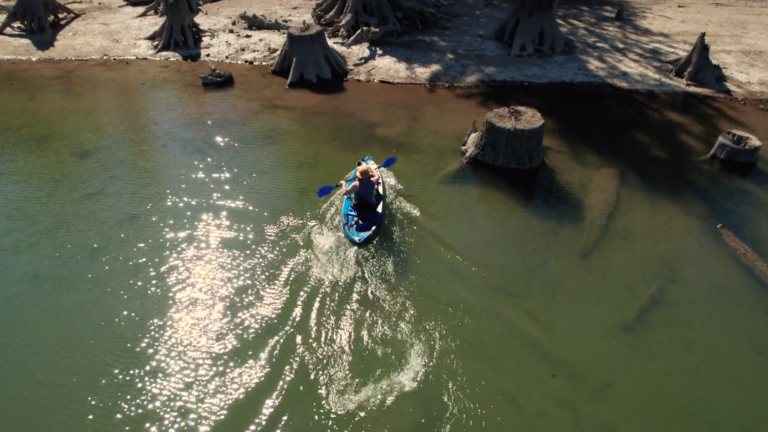If you want to catch crappie consistently, under almost any conditions, then you’ll want plenty of jigs. More crappie is caught on jigs than by any other method, including live bait.
They can be cast, flipped, or fished straight up and down from a rod or cane pole, hence the term jigging.
They are very weed-resistant, and in some cases, downright weedless, so they can be used in the heaviest cover, where even the bravest minnows fear to tread.
Table of Contents
ToggleUnrigged Jigs For Crappie

Simply stated, a jig is a lead ball, oval, or another shaped sinker, permanently molded to the hook shank behind the hook-eye. They normally are made to ride “hook-up” to avoid getting snagged on the bottom or in cover.
A body of soft plastic is threaded on the hook behind the head. Bodies come in all shapes, sizes, and colors imaginable (and some are really scary-looking).
They can imitate crawfish, various types of minnows, sunfish and shad, and things that only exist in nightmares!
An unrigged jig is just the head and the hook. Sometimes they come with plastic bodies, but can also be purchased separately. This type of jig has the advantage of allowing you to change colors and body styles rapidly on the water. Usually, a minnow scent is added to all jigs (more about scents later).
To rig them, simply thread the body up the hook, leaving the body to track straight.
You can also tip them with a minnow, alive or dead.
Rigged Jigs For Crappie

These jigs already have bodies threaded or tied to them. The tied bodies are not removable as a rule. The most famous of these is the incredible Marabou and Bucktail jigs, possibly the most versatile and successful fishing lures ever invented.
If you could only have one or two lures, these would be it. They can be fished deep or shallow, vertically fished or cast. They can go in open water or heavy cover and are particularly good for drop-shotting.
Unrigged jigs can be tipped with plastic bodies that are made in any shape you can imagine, and some you probably haven’t imagined. Lizards, squid, crawfish, misshapen minnows, etc…. For crappie, tube jigs, minnow bodies, and grubs work the best.
Another type of jig that some prefer is the ‘Roadrunner’ jig. It has a horse-shaped head, and a spinner blade, and gets down deep, very quickly. It is also very snag-resistant, so it is good in heavy cover. Just thread on a body, and it’s good to go…
And lastly, for the soft-bodied jigs, there is the ‘Slider’ jig. This jig has a uniquely-shaped hook shank with a ‘crook’ in it to allow rigging the plastic body in a manner that allows the body to undulate more naturally, and is virtually weedless, since the hook point and barb are buried in the body.
It is very similar to a Texas-Rigged worm and can be accomplished on a regular jig hook with a slight modification. These are popular with ‘finesse’ aficionados, who prefer delicate presentations.
These jigs are very effective at times.
The most common and productive jigs for crappie are those that have marabou permanently tied to the shank. This is the stereotypical crappie jig. The best size is usually 1/8 oz. for most of the year, dropping down to a 1/16th oz. in the middle of winter when crappie can get a bit picky.
Standard productive colors are, from the best down, chartreuse, yellow, white, black, or even better, combinations of these colors.
Bucktail jigs are like marabou, except they use the hair from the tail of a deer, rather than turkey down-feathers. They have a little less action in the water but are also incredibly effective. Either one is a good choice.
With very few exceptions, most of the techniques can be used with all types of jigs. They can be fished singly, or in tandem, with two types or colors of jigs. One of my favorite techniques in moving water is to rig two jigs under a float and let the current carry them downstream.
It can be deadly at times. Jigs can be fished under a float for precise depth control.
Without question, the jig is the most cost-effective and productive way to catch crappie. Many types of jigs cost less than live bait, and you don’t have to worry about keeping them alive, or what to do with the ones you didn’t use. If pennies count in your budget, then jigs are the way to go.
On a side note, there is added fun to be had with jigs. You can cast your own jig heads and soft bodies, and tie your own marabou jigs very easily in the comfort of your home. The kits and equipment are very inexpensive and will provide you with a lifetime of service. Making your own lures is as much fun as fishing with them. It’s something worth looking into.
Happy Fishing
Take a look at more jigs for fishing
Adelaide Gentry, a seasoned kayaking enthusiast and expert, is the driving force behind KayakPaddling.net. With over a decade of experience navigating the world’s most challenging waterways, Adelaide combines her passion for adventure with a deep knowledge of kayaking to provide insightful and practical guidance for paddlers of all levels.
Related Posts:
- Heavy Duty Fishing: 11 Best Rods And Reels For Big Fish 2025
- 12 Best Fishing Lures Ever 2025 - Baits That…
- 16 Best Kayak For Beginners 2025 - Kayaking Adventure Gear
- 10 Best Inflatable Kayak 2025 - Rivers, Lakes & Open Seas
- 10 Best Fish Finders Under $200 2025 - Top Affordable Picks
- 10 Best Saltwater Fishing Boats - Ultimate Angling Adventure












